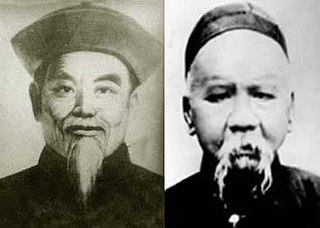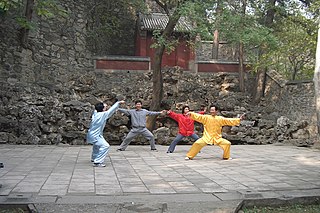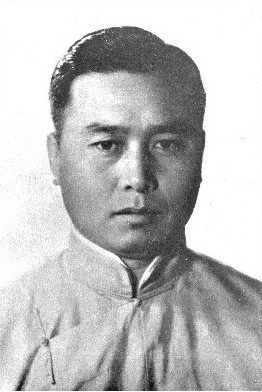This article possibly contains original research .(March 2016) |
| Part of a series on |
| Chinese martial arts (Wushu) |
|---|
 |
List of tai chi forms, postures, movements, or positions in order of number of forms:
This article possibly contains original research .(March 2016) |
| Part of a series on |
| Chinese martial arts (Wushu) |
|---|
 |
List of tai chi forms, postures, movements, or positions in order of number of forms:

Neijia is the collective name for the internal Chinese martial arts. It relates to those martial arts occupied with spiritual, mental or qi-related aspects, as opposed to an "external" approach focused on physiological aspects. The distinction dates to the 17th century, but its modern application is due to publications by Sun Lutang, dating to the period of 1915 to 1928. Neijing is developed by using neigong or "internal changes", contrasted with waigong or "external exercises".

Tai chi is an internal Chinese martial art practiced for self-defense and health. Known for its slow, intentional movements, tai chi has practitioners worldwide and is particularly popular as a form of gentle exercise and moving meditation, with benefits to mental and physical health.

Zhang Sanfeng refers to a legendary Chinese Taoist who many believe invented tai chi. However, other sources point to early versions of tai chi predating Sanfeng. He was purported to have achieved immortality.

Wu (Hao)-style tai chi is one of the five primary styles of tai chi. It was created in the mid-nineteenth century by Wu Yuxiang, a member of a wealthy and influential family in Yongnian, Hebei, China. Wu trained for approximately ten years with the founder of Yang-style tai chi, and then for over a month with a Chen-style master. Wu also obtained a manual on internal martial arts that formed the core of what are now known as the tai chi classics and include Wu's own writing on the subject. From these sources Wu and his family developed their own style, and may also have developed much of the cultural and intellectual foundation of tai chi as well.

Yang-style tai chi is one of the five primary families of tai chi. Including its variations, it is the most popular and widely practised style of tai chi in the world today. It is second in terms of seniority, after Chen-style tai chi.

The Chen-style tai chi is a Northern Chinese martial art and the original form of tai chi. Chen-style is characterized by silk reeling, alternating fast and slow motions, and bursts of power.

Chen Fake, courtesy name Chen Fusheng (福生), was a Chinese martial artist who taught Chen-style tai chi. He was born and raised in Chen Family Village in Henan province. In 1928, Chen Fake relocated to Beijing to teach his family's heritage, Chen-style tai chi. After successfully defeating numerous challengers, Chen garnered a following of students, including several renowned martial artists. As a martial artist rather than a scholar, Chen Fake did not leave behind a written record of his accomplishments. His life story was recounted and preserved by his sons and students, most notably Hong Junsheng. By the time of his death in 1957, Chen had firmly established the global practice of Chen-style tai chi, creating a martial arts tradition that continues to thrive.

Yang Shaohou was a Chinese martial arts master who, along with Yang Chengfu, represents the third generation of Yang-style tai chi. Grandmaster of his generation and known for his compact "small frame" techniques, he was a ferocious fighter and a demanding teacher.

Wu Yinghua (1907–1996) was a famous Chinese teacher of Wu-style tai chi. She was born in Beijing and died in Shanghai. She was the eldest daughter of Wu Jianquan, the best known teacher of Wu-style tai chi. Her older brothers were Wu Gongyi and Wu Gongzao, also well-known tai chi practitioners.
Taijijian is a straight two-edged sword used in the training of the Chinese martial art tai chi. The straight sword, sometimes with a tassel and sometimes not, is used for upper body conditioning and martial training in traditional tai chi schools. The different family schools have various warmups, forms and fencing drills for training with the jian.
Scott M. Rodell is a martial artist, author, and teacher of Yang-style taijiquan. He is the founding director of Great River Taoist Center, a non-profit organization based in Washington, D.C.
Chen Weiming (1881–1958) was a scholar, tai chi teacher, and author. He was also known by his name Chen Zengze (陳曾則), Weiming being his hao, a pen-name.
The different slow-motion solo form training sequences of tai chi are the best-known manifestations of tai chi for the general public. In English, they are usually called the hand form or just the form. In Mandarin, it is usually called quan.

Wudangquan is a class of Chinese martial arts. In contemporary China, Chinese martial arts styles are generally classified into two major groups: Wudang (Wutang), named after the Wudang Mountains; and Shaolin, named after the Shaolin Monastery. Whereas Shaolin includes many martial art styles, Wudangquan includes only a few arts that use the focused mind to control the body. This typically encompasses tai chi, xingyiquan and baguazhang, but must also include bajiquan and Wudang Sword. Although the name Wudang distinguishes the skills, theories and applications of the internal arts from those of the Shaolin styles, these arts did not originate in the Wudang Mountains: the name Wudang comes from a popular Chinese legend that purports the genesis of tai chi and Wudang Sword by an immortal, Taoist hermit named Zhang Sanfeng who lived in the monasteries of Wudang Mountain. Wudang quan is often used synonymously with Neijia, but Neijia is a broader term that also encompasses Aikido and Qigong, which are not Wudang quan.

Dong Yingjie was a leading master of tai chi, and a top disciple of Yang Chengfu. Born in Ren County, Hebei, China, his given name was Wenke (文科). Famous in his time for defeating a foreign boxer in a public challenge match, he dedicated his life to the martial arts, training intensively in multiple styles, serving as chief assistant instructor for Yang Chengfu, and going on to found his own thriving tai chi legacy.

Dong Huling was a master of tai chi, known for teaching Yang style and Dong style, and an early leader in the spread of tai chi worldwide. Born in Ren County, Hebei, China, his father Dong Yingjie was a top disciple of Yang Chengfu and famous for his fighting skills. Also highly skilled and creative himself, Dong Huling taught in mainland China, Hong Kong, Macau, Southeast Asia, North America, and Europe. He then emigrated to Hawaii, founding a school in Honolulu, continued teaching workshops around the world, and carried on the Dong family legacy.

Wu-style tai chi is one of the five main styles of tai chi. It is second in popularity after Yang-style, and the fourth-oldest of the five major tai chi styles. It was developed by Wu Quanyou and Wu Jianquan.

Joseph Chen Zhonghua, also known by his courtesy name Dongliang is a Chinese martial arts practitioner, teacher, and author from Shandong, China. Chen studied under two experts of the eighteenth generation of Chen-style tai chi, Hong Junsheng and Feng Zhiqiang. In 1985, Chen and his family emigrated to Canada, where he began to promote Hong's version of Chen-style tai chi to a western audience. In 2005, Chen was designated by Hong family as the International Standard Bearer of Hong's Practical Method, during a ceremony held in Jinan. Since 2006, he has overseen a residential tai chi training program on Daqingshan in Shandong.
Hong Junsheng, born in 1907 in Henan, China, was a Chinese martial arts practitioner, teacher and author. Hong was the longest serving disciple for the Chen-style tai chi master Chen Fake. Starting in 1930, Hong trained uninterrupted with Chen for fifteen years. In 1944, Hong moved to the city of Jinan in Shandong Province. In 1956, he returned to Beijing to study again with his teacher, Chen Fake. Later, Hong expressed his understanding of Chen Fake's teachings of tai chi through his own teachings and writings. These theories and training principles are now known as the Chen-style tai chi Practical Method.
Cheng Wing Kwong was a disciple (Tudi) of Wu Jianquan, the founder of Wu Style Taijiquan. He was born in Niao Shi, Zhongshan, Guangdong, China.